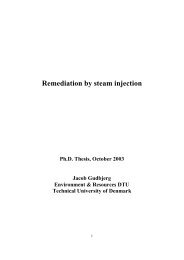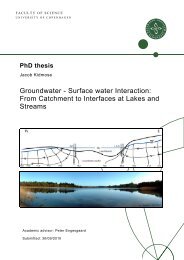Groundwater arsenic in the Red River delta, Vietnam ... - Fiva
Groundwater arsenic in the Red River delta, Vietnam ... - Fiva
Groundwater arsenic in the Red River delta, Vietnam ... - Fiva
You also want an ePaper? Increase the reach of your titles
YUMPU automatically turns print PDFs into web optimized ePapers that Google loves.
Jessen et al., manuscript to be submitted to Geochim. Cosmochim. Acta<br />
level decreases later <strong>in</strong> <strong>the</strong> ra<strong>in</strong>y season, <strong>the</strong> head <strong>in</strong> <strong>the</strong> Holocene aquifer exceeds <strong>the</strong><br />
channel stage, caus<strong>in</strong>g upward discharge of groundwater to <strong>the</strong> channel. Towards <strong>the</strong><br />
end of <strong>the</strong> ra<strong>in</strong>y season, <strong>the</strong> groundwater head gradually lowers, <strong>the</strong> channel becomes<br />
aga<strong>in</strong> disconnected, and <strong>in</strong> <strong>the</strong> <strong>in</strong>itial part of <strong>the</strong> follow<strong>in</strong>g dry season <strong>the</strong> channel stage<br />
aga<strong>in</strong> exceeds <strong>the</strong> head of <strong>the</strong> Holocene aquifer.<br />
Fig. 5 shows <strong>the</strong> water level <strong>in</strong> <strong>the</strong> channel and <strong>in</strong> <strong>the</strong> two observation wells N1<br />
and N4 (Fig. 1 and 2) from 25 days before <strong>the</strong> start of pump<strong>in</strong>g, followed by 55 days of<br />
cont<strong>in</strong>uous pump<strong>in</strong>g (Fig. 1b and 2). From day -25 to day 34, <strong>the</strong> head <strong>in</strong> <strong>the</strong> channel is<br />
above that observed <strong>in</strong> N1 and N4, but on day 34 <strong>the</strong> channel head decreases to below<br />
<strong>the</strong> well heads. Pump<strong>in</strong>g was <strong>in</strong>itiated on 7 July 2007 (day zero), when <strong>the</strong> channel<br />
became connected to <strong>the</strong> <strong>Red</strong> <strong>River</strong>, flood<strong>in</strong>g first <strong>the</strong> flat sandy channel bottom and<br />
later also <strong>the</strong> bank slope (Fig. 2). Fig. 5b shows <strong>the</strong> gradient between <strong>the</strong> two<br />
observation wells N1 and N4. Unfortunately, <strong>the</strong> observations <strong>in</strong> Fig. 5b have a large<br />
and possibly systematic uncerta<strong>in</strong>ty, but still <strong>the</strong> change <strong>in</strong> flow direction <strong>in</strong>duced by <strong>the</strong><br />
pump<strong>in</strong>g is significant. Dur<strong>in</strong>g day zero to around day 35, <strong>the</strong> head difference (Fig. 5b)<br />
between N1 and N4 <strong>in</strong>fers a flow from <strong>the</strong> channel towards <strong>the</strong> pump<strong>in</strong>g wells (Fig. 1b<br />
and 2). When <strong>the</strong> channel stage drops after 30 days of pump<strong>in</strong>g, <strong>the</strong> gradient reverses<br />
(Fig. 5b), <strong>in</strong>ferr<strong>in</strong>g flow <strong>in</strong> <strong>the</strong> opposite direction. Hence, <strong>the</strong> natural hydraulic gradient<br />
between <strong>the</strong> groundwater head and <strong>the</strong> channel head overrides <strong>the</strong> effect of <strong>the</strong> susta<strong>in</strong>ed<br />
pump<strong>in</strong>g.<br />
3.2.1.1. Isotopic composition. In order to identify more directly <strong>the</strong> source of <strong>the</strong> water<br />
drawn to <strong>the</strong> transect by pump<strong>in</strong>g, we analyzed 18 O and 2 H <strong>in</strong> groundwater and<br />
channel water samples of day 9, 34 and 54 (Fig. 9). The groundwater sampled from N1<br />
14





